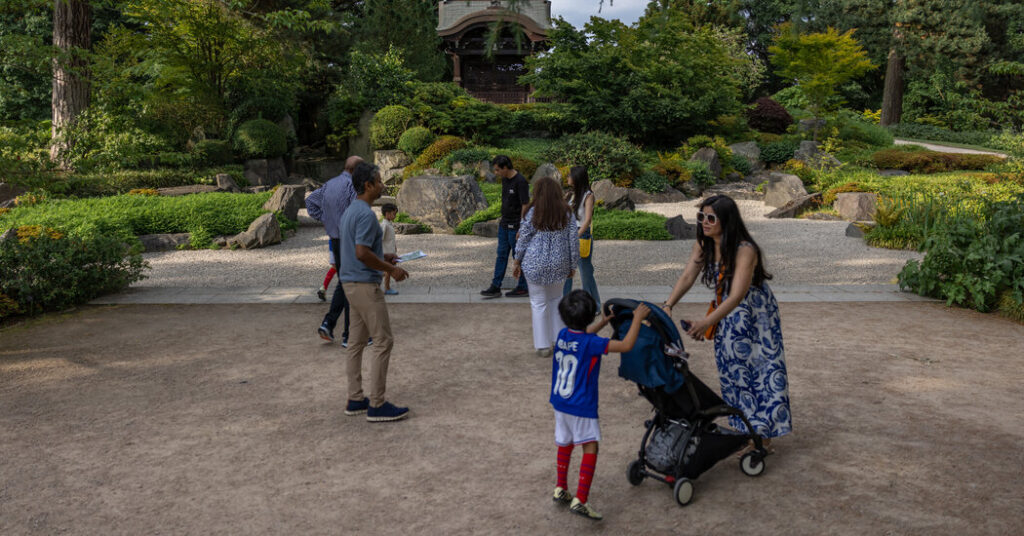The island nation’s links with the famous London landmark will be on full display when Japan’s Emperor Naruhito and his wife, Queen Masako, visit Kew Gardens as part of a state visit to the UK.
The 330-acre arboretum, dotted with plants, is a constant reminder of this long-standing relationship. In a large greenhouse, bronze sculptures of bonsai trees—some nearly as tall as the room—pay homage to the Japanese gardening art form. A short walk away is the Japan Gate, a beautifully carved cypress replica of a Kyoto temple. Nearby, gravel is neatly raked into waves and swirls, surrounded by Japanese plants reminiscent of traditional tea gardens.
Dignitaries and heads of state from many countries regularly visit Kew Gardens during official visits, joining the approximately 2.3 million annual visitors to one of London’s most popular tourist destinations. However, for emperors and empresses, the site may have had greater relevance.
Richard Deverell, Director of the Royal Botanic Gardens, said: “We have a long and close relationship with Japan, which can be seen in several of the beautiful buildings in our landscape and in our Seen in the living collections as well as the economic botany and art collections.
The 64-year-old emperor’s lineage stretches back more than 15 centuries, making the Chrysanthemum Throne the oldest monarchy in the world. But much like the role of the British royal family, the Japanese royal family’s role is symbolic and independent of the country’s government.
Thursday’s trip is part of the couple’s week-long visit to Britain, a country with which they have long had personal ties. Both attended Oxford University in the 1980s—the emperor was then the crown prince; the empress was part of a Japanese Foreign Ministry program that sent early-career diplomats to study abroad.
The connection between Japan and Kew Gardens dates back to the early 20th century.
Since the early 20th century, the royal families and imperial families of Britain and Japan have had close relations. In 1902, the two countries signed the Anglo-Japanese Alliance, an agreement that promoted cooperation and cultural exchanges.
As Britain became increasingly interested in its new ally, exhibitions of Japanese art became popular. According to the Japanese Embassy in London, the 1910 Japan-British Exhibition in London attracted more than 8 million visitors. Among them was Queen Mary, wife of King George V and Queen Elizabeth II’s grandmother, and an avid collector of Japanese art.
The connection between Kew Gardens and Japan has spanned generations. The Japan Gate is a scaled-down replica of the gate of Nishi Honganji Temple in Kyoto, made of hinoki cypress and installed in 1911 after being exhibited at the Japan-British Exhibition in London the year before.
After the Japan Gate was restored in 1996, the Emperor’s sister (then Princess Sayoko) officially opened the temple replica and new traditional landscaping. (She lost her title when she married and became a private citizen in 2005.) At the dedication ceremony, she planted a northern Japanese magnolia, which still grows at Kew Gardens.
The Japanese art of bonsai will be highlighted during the visit.
Little gems from Kew Gardens’ impressive bonsai collection will be on display when the royal couple visit the historic Temperate Palace, one of the Botanic Gardens’ Victorian greenhouses.
Bonsai, the growing and shaping of miniature trees in containers, often requires years of work by skilled artists. One of the highlights of the collection of 60 bonsai trees at Kew Gardens is a small bonsai tree only 10 centimeters tall, and another is 180 years old.
Richard Kernick, botanic horticulturist at Kew Gardens, said that while bonsai trees are often thought of as dwarfs, they are actually trees that have been professionally pruned and shaped to prevent them from growing to their full size .
“This complex and precise art form transforms trees into tiny living treasures,” he said. “A living bonsai is a work of art that is never finished and often outlives its artist. Inheriting a tree is like a rung on a ladder – there are usually many rungs behind it and hopefully many rungs ahead.
The greenhouse also features a series of bronze bonsai sculptures by British artist Marc Quinn, as well as some of the rarest plants from around the world.
The emperor will meet Masumi Yamanaka, Japan’s first botanical artist-in-residence, at Kew Gardens, who will talk about her paintings of the Miracle Pine, which became a symbol of hope after Japan’s devastating 2011 tsunami.
A visit to Kew Gardens is just one stop on the royal tour.
The couple arrived in the UK on Saturday and also spent time with the British royal family. Prince William met them at their hotel on Tuesday to kick off their official visit, and King Charles III and Queen Camilla will host them at a formal state dinner at Buckingham Palace in the evening.
King Charles, 75, and the emperor have much in common – including their sometimes niche interests, public scrutiny of their marriage and an obsession with family life.
Both are relatively new monarchs. Naruhito became emperor in 2019 when his father, Emperor Akihito, abdicated, while Charles was crowned king in 2022 after the death of his mother, Queen Elizabeth II. The Japanese royal family will visit Oxford on Friday, the final day of their visit.
The Emperor and Empress also visited several other sites, including the Japan House, a cultural center in London, and the Thames Barrage, one of the largest movable flood defenses in the world. While the barrier seemed like a random stop for members of the royal family, the emperor was probably more interested than many tourists.
The title of his memoirs of his two years at Oxford is The Thames and Me, a nod to the influence of the Thames on his time there and to his university thesis, which was on the history of river transport in the 18th century.
Rich Yuan Reporting from Tokyo.

